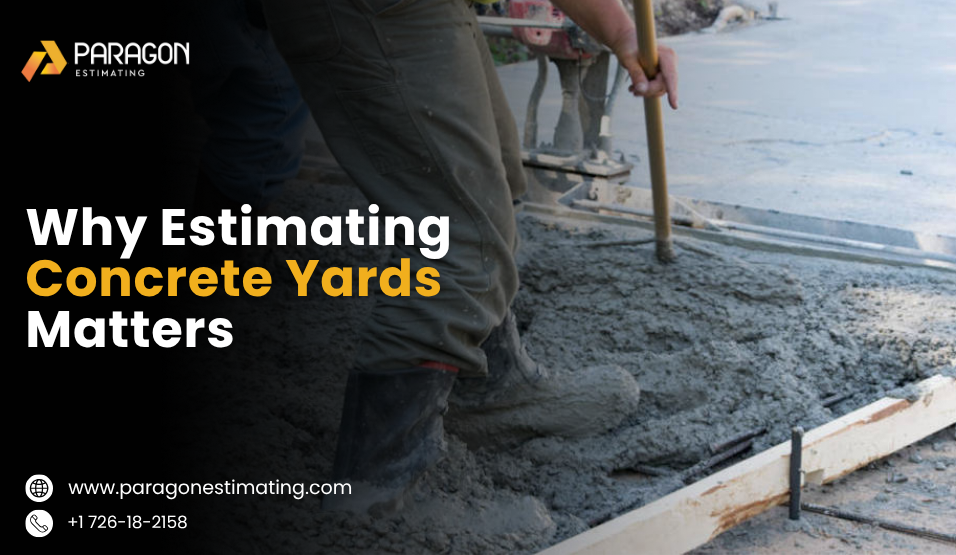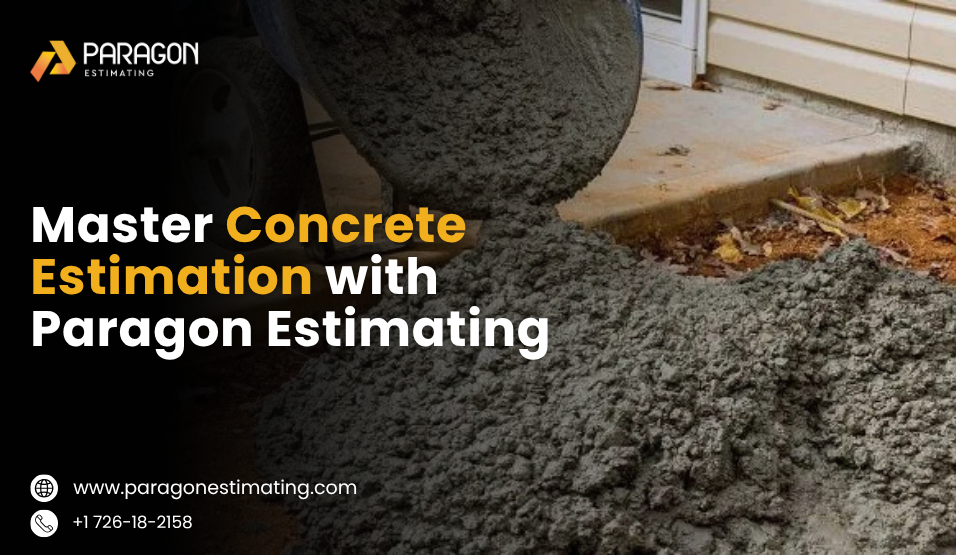Why Estimating Concrete Yards Matters
In the case of renovation and construction projects, accurate estimation of materials is crucial. The most popular materials employed are concrete, and estimate concrete yards can help you save time as well as money and headaches. If you’re a contractor, builder, or DIY enthusiast, knowing this method will ensure your project goes smoothly without costly over-orders or delays caused by shortages.
In Paragon Estimating, we specialize in exact construction cost estimation. Today, we’ll help you understand the easy but essential method of how to estimate concrete yards. Let’s begin.

What Is a Concrete Yard?
Before we begin to calculate, we need to understand what a concrete yard is. “A yard” in construction terms generally is a reference to the cubic yard, which is a unit that measures volume, not length.
- 1 cubic yard = 27 cubic feet
- It determines the quantity of concrete required to fill a certain space.
Concrete is categorized by volume since it’s made and then shaped to fill spaces or forms.
Why Accurate Concrete Estimation Matters
Imagine laying the driveway or creating the foundation. Insufficient concrete orders can cause construction delays as well as rush orders and cost overruns. If you order too many? You’re at risk of wasting costly materials as well as money or storage space.
Accurate concrete estimation helps you:
- Be mindful of the limits of your budget
- Avoid project delays
- Reduce the amount of waste generated and the environmental impact
- Be clear in communicating with suppliers as well as clients.
This is the reason being able to accurately estimate concrete yards is a vital ability in the field of construction.
Step-by-Step: How to Estimate Concrete Yards
If you’ve ever wanted to know how to estimate concrete yards without worrying about overspending or running out of money, follow these easy but tested steps. Let’s go through them exactly as we do for our clients in Paragon Estimating.
Step 1: Measure the Area
Use a tape measure to record the width, length, and thickness of the area you’d like to fill with concrete. Always measure in feet to ensure exactness. A slight error could affect the final amount.
Example:
- Length 10 feet
- Width 8 feet
- The depth is 0.5 meters (6-inch-thick slab)
Step 2: Calculate the Volume in Cubic Feet
Multiply length by width by depth.
For Tom’s slab, 10×8 x 0.5 is 40 cubic feet
Step 3: Convert Cubic Feet to Cubic Yards
As 1 cubic yard is 27 cubic feet of space, you can divide the total cubic feet of your yard by 27.
40 / 27 1.48 cubic yards
Tom has rounded the maximum of 1.5 cubic yards of space to ensure that you are secure.
Step 4: Add Extra for Waste and Spillage
Concrete isn’t always flawless. There are times when concrete gets ruined during pouring or because of uneven terrain. Adding 5-10% extra ensures you won’t run short.
For 1.5 cubic yards, adding 10% means:
1.5 x 1.10 = 1.65 cubic yards
Step 5: Final Order Quantity
Tom requested 1.65 cubic yards of concrete. This included an additional 10% buffer to prevent spills and waste. This ensured that the pour was done in one sitting, which avoided costly delays and cold joints. The little surplus also allowed the designer to construct a lovely garden path that was a win in terms of budget and outcomes.
Common Concrete Estimating Mistakes to Avoid
A lot of people make the following mistakes:
Misjudging Depth or Thickness
Incorrectly measuring depth can create enormous estimation mistakes. Always make use of a tape measure and double-check.
Forgetting Waste Factor
By skipping this extra 5-10%, it can mean you’re out in the middle of your pour, requiring you to purchase additional concrete for a greater cost and run the risk of apparent seams or weak points on the surface.
Ignoring Concrete Mix Types
Different mixes have different densities as well as volumes required. Know the specifications of your mix before making a purchase, since mixing the wrong mix could alter the quality, strength, and finish quality and durability.
Tools to Help Estimate Concrete Yards Easily
Technology has made life simpler. Here are a few tools Tom employed to increase his estimations:
- Concrete Calculator Apps: Online tools that allow you to enter dimensions and immediately get estimates of cubic yards.
- Digital Tape Measure: Fast and accurate measurement.
- Estimation Software: For contractors who are managing multiple projects.
How to Estimate Concrete Yards for Different Projects
Every project is unique and has unique requirements. Let’s look at different estimate concrete yards.
Estimating Concrete for Driveways
Driveways are typically 4 inches wide. These numbers are:
- Length x Width x Depth (in feet)
- Here, the depth would be 0.33 inches. (4 inches)
Add 5-10% to the spillage.
Estimating Concrete for Foundations
Foundation depth varies widely. Take measurements of width, length, and depth with care. Always add more for footings or walls that are thicker.
Estimating Concrete for Patios
Patios are usually 6 to 8 inches in thickness. Take exact measurements and include the edge or step.
How Paragon Estimating Can Help You
Estimate concrete yards could appear straightforward; however, it can become complicated when there are big construction projects or with mixed materials.
- Rapid and precise volume estimations
- Complete cost breakdowns
- Customized reports tailored to your specific project
- Support for contractors, builders, and homeowners
Conclusion: Master Concrete Estimation using Paragon Estimating
Knowing how to estimate concrete yards can make all the difference in your construction’s success. If you’re working on a small patio or a massive foundation, following the correct steps will ensure that you purchase the right amount, avoid wasting money, and make sure your project stays on track.
In Paragon Estimating, we understand the difficulties builders confront. Our professional services will offer you precise and concrete estimates customized to your requirements, helping to build your home with confidence. Are you ready to make concrete easier for your next project? Contact Paragon Estimating today for a no-cost consultation and a precise estimate concrete yards that you can trust!

FAQs
How do I calculate concrete yards for a slab?
Take measurements of the slab’s width, length, as well as thickness, in inches. Multiply these three numbers to calculate cubic feet. Divide by 27 and convert into cubic yards. Be sure to add 5-5% to cover garbage.
What is the best way to avoid over-ordering concrete?
Accurate measurements and an acceptable amount of waste aid. Utilizing digital tools and professional estimators such as Paragon Estimating can avoid costly errors.
Can I estimate concrete yards without a calculator?
It’s much easier and more precise to use a calculator or an online tool. Calculations made by hand are simple, but are susceptible to human errors.
The minimum required thickness for the concrete slab?
4 inches is typical for patios and sidewalks. For foundations or driveways, the thickness is dependent on the load and the design.
What is the effect of the type of concrete mix impact estimation?
Different mixes come with different densities and air content that can alter volume a bit. Be sure to verify the specifications of the mix in conjunction with the supplier.


